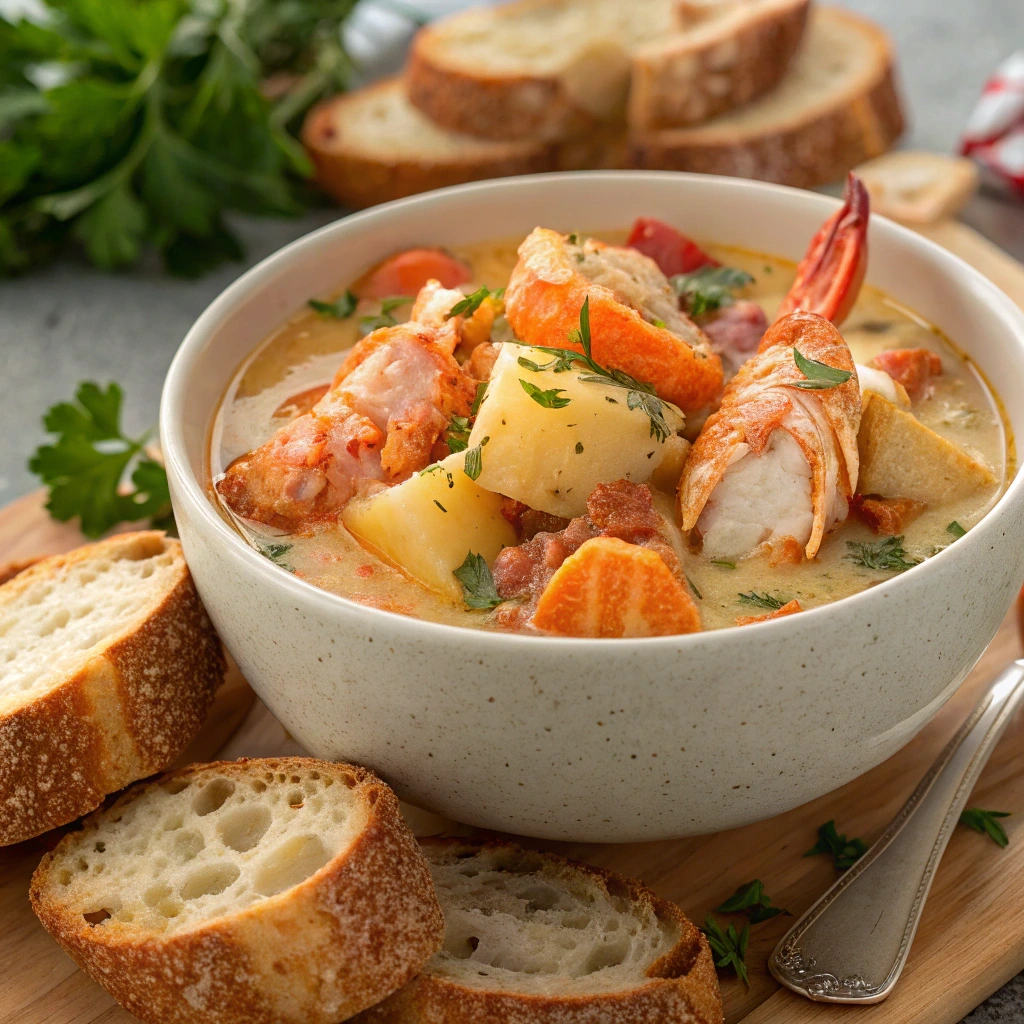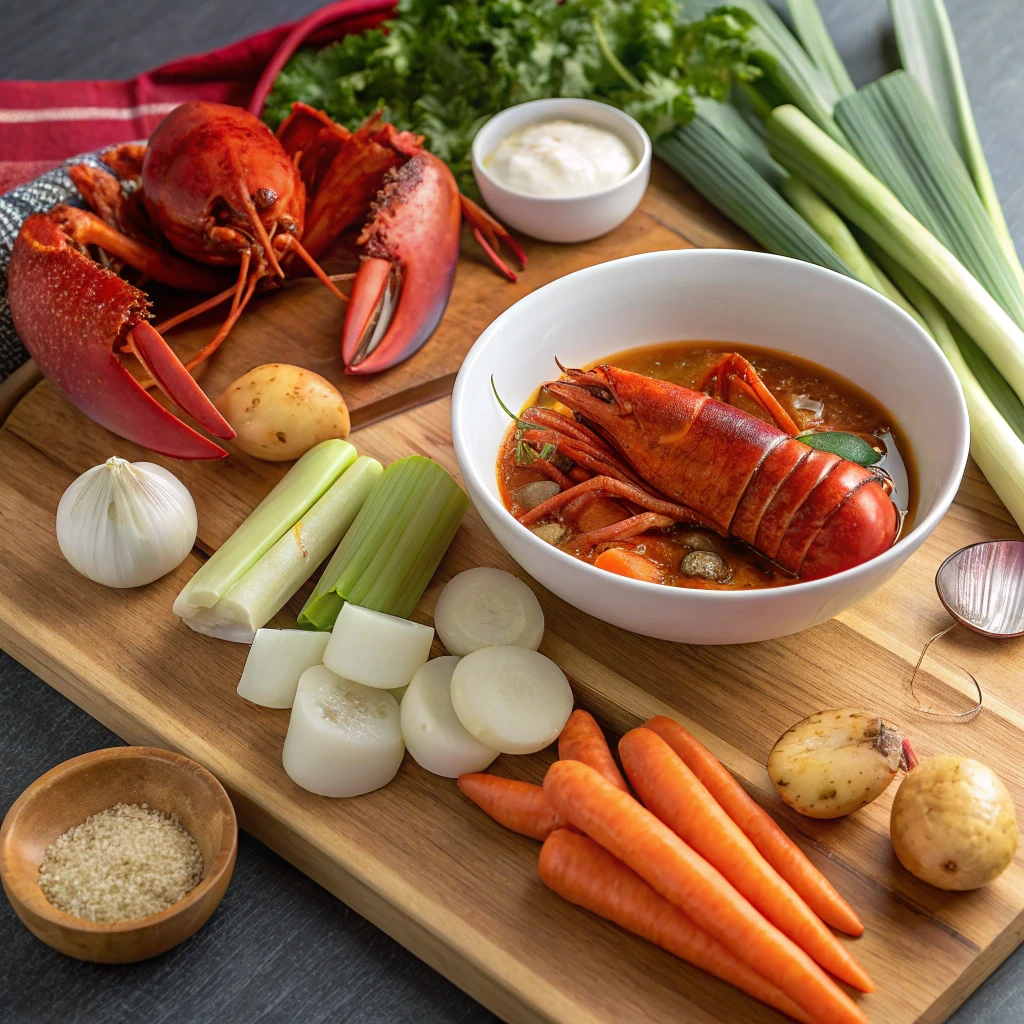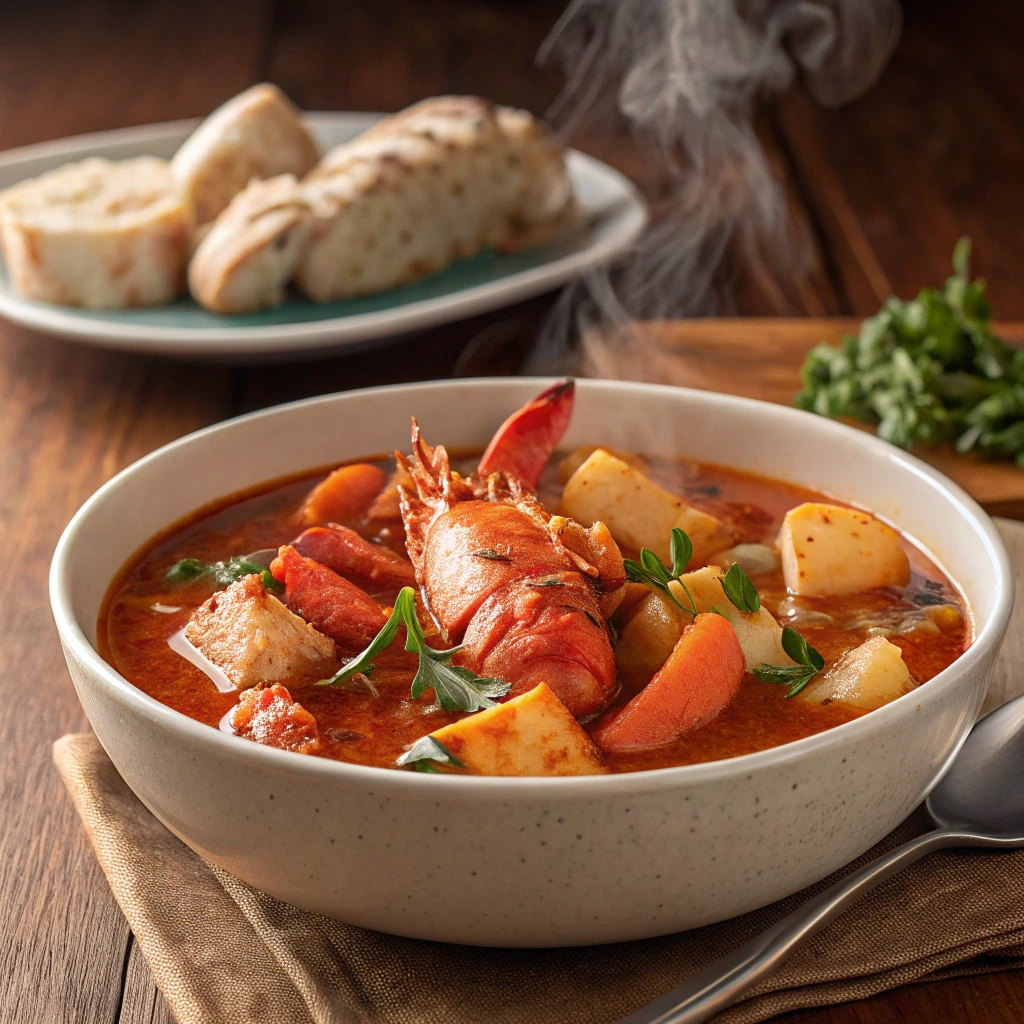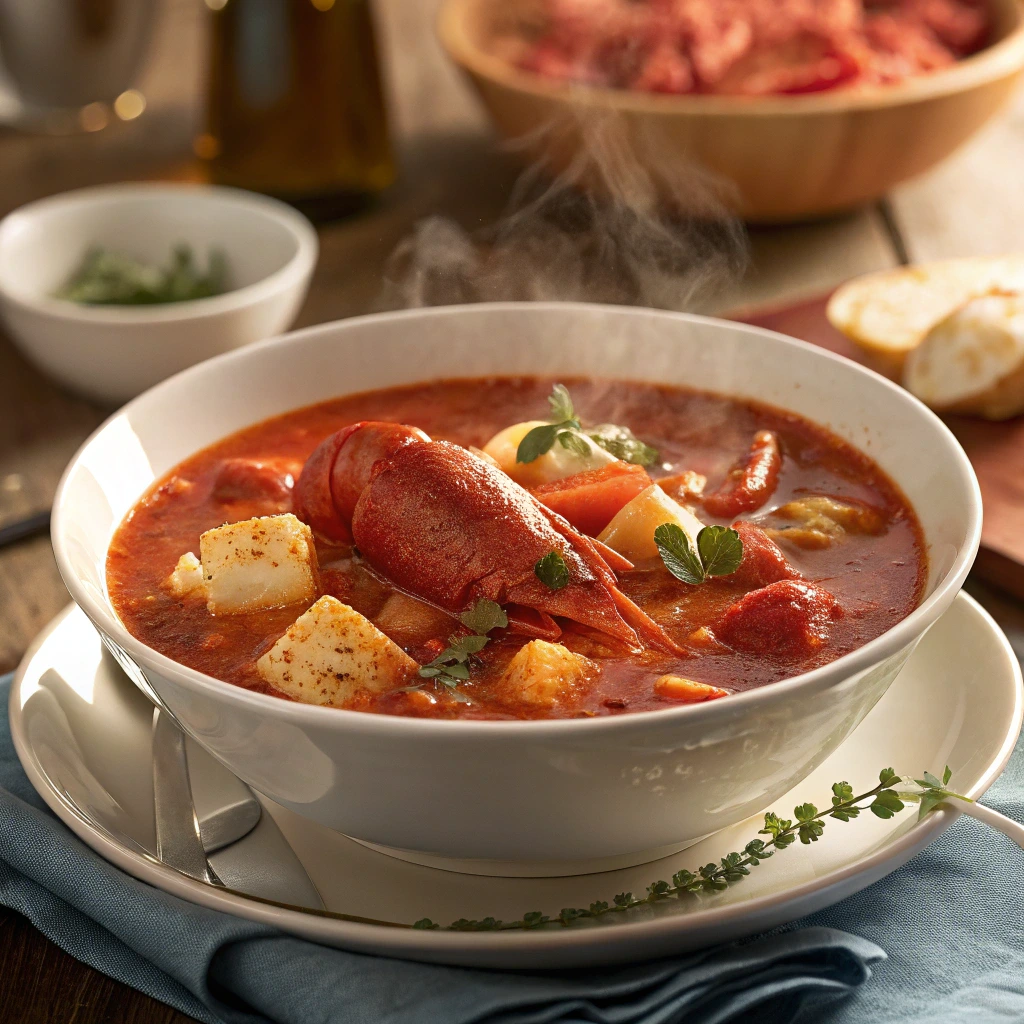
introduction:Why Lobster Stew Should Be Your Next Culinary Adventure
Imagine this: a steaming bowl of creamy, rich lobster stew placed before you on a chilly evening. The aroma of fresh seafood mingles with the warmth of butter and herbs, instantly transporting you to the rugged coastline of New England. This isn’t just any dish—it’s comfort food elevated to an art form.
If you’ve ever hesitated to try making lobster stew at home because it seemed intimidating or overly complicated, let me assure you: it’s easier than you think. With this step-by-step guide, you’ll learn how to create a luxurious seafood masterpiece that will impress your family and friends—and satisfy your cravings for something truly special.
By the time you finish reading, you’ll not only know how to make lobster stew but also feel confident enough to experiment with flavors and techniques to make the recipe uniquely yours. So grab your apron, and let’s dive into the world of creamy, indulgent lobster stew together.
What is Lobster Stew? (Introduction to the Dish)
The Origins of Lobster Stew
- Explore the history of lobster stew as a coastal dish tied to New England traditions.
- Discuss how coastal communities relied on lobster as a staple ingredient due to its abundance.
- Mention its evolution from humble beginnings to gourmet status in modern cuisine.
- Highlight its cultural significance as a symbol of seaside dining and luxury.
Lobster Stew vs. Lobster Chowder
- Clarify the differences between lobster stew and lobster chowder.
- Explain that lobster stew typically has a thinner consistency compared to the thicker, creamier texture of chowder.
- Note that lobster stew focuses more on the pure essence of lobster flavor, while chowder often includes potatoes and other hearty ingredients.
Why You Should Try Making Lobster Stew at Home
- Emphasize the ease of preparation and rich flavor profile of lobster stew.
- Reassure beginners by noting that even novice cooks can master this dish.
- Use emotional appeals like “impress your guests” or “elevate your weeknight dinners.”
Tools You’ll Need for Perfect Lobster Stew
- List essential kitchen tools needed for making lobster stew.
- Include items like a large stockpot, sharp chef’s knife, cutting board, ladle, and whisk.
- Optionally mention high-quality brands like Le Creuset or All-Clad for durability.
Ingredients You’ll Need for Lobster Stew
Table: Key Ingredients for Lobster Stew
| Category | Ingredients | Notes |
|---|---|---|
| Protein | Fresh lobster meat | Can substitute with frozen if necessary |
| Dairy | Heavy cream, unsalted butter | Opt for coconut milk for dairy-free option |
| Liquids | Seafood stock, white wine (optional) | Homemade stock adds extra depth |
| Vegetables & Seasoning | Onions, garlic, parsley, thyme | Fresh herbs enhance flavor significantly |
Fresh Lobster Meat: The Star Ingredient
- Explain why fresh lobster meat is ideal but acknowledge that frozen works too.
- Provide tips for thawing frozen lobster properly (e.g., overnight in the fridge).
- Suggest using lobster shells to make homemade seafood stock for added richness.
Essential Seasonings and Herbs
- Highlight key seasonings and herbs like parsley, thyme, bay leaves, and paprika.
- Describe their roles in enhancing the overall flavor profile of the stew.
- Encourage readers to use fresh herbs whenever possible for maximum impact.
Creamy Base Ingredients
- Focus on heavy cream, butter, and seafood stock as the foundation of the stew.
- Offer alternatives for dietary restrictions, such as almond milk or olive oil.
- Stress the importance of balancing creaminess without overwhelming the lobster flavor.
Optional Add-Ins for Extra Flavor
- Suggest optional ingredients like diced potatoes, carrots, or celery for heartiness.
- Recommend splashing in white wine for acidity and complexity.
- Allow room for personalization based on taste preferences.

Step-by-Step Instructions for Making Lobster Stew
Preparing Your Ingredients
- Walk through prepping vegetables and lobster meat.
- Instruct readers to chop onions, mince garlic, and dice optional veggies like potatoes.
- Remind them to clean and devein lobster meat thoroughly.
Cooking the Base
- Detail sautéing onions and garlic in butter until fragrant.
- Add herbs like thyme and bay leaves during this step for infused flavor.
- Build layers of flavor by deglazing the pan with a splash of white wine.
Adding the Seafood Stock and Cream
- Combine seafood stock and heavy cream in the pot over medium heat.
- Stir gently to avoid curdling the cream.
- Simmer the mixture to reduce slightly and intensify flavors.
Finishing Touches: Bringing It All Together
- Gently fold in the lobster meat and simmer briefly to cook through.
- Season with salt, pepper, and a squeeze of lemon juice for brightness.
- Garnish with fresh parsley before serving hot.
Tips for Elevating Your Lobster Stew
How to Infuse Extra Flavor
- Suggest simmering lobster shells in the seafood stock for deeper flavor.
- Recommend reducing the sauce further for a richer taste.
Pairing Suggestions for Lobster Stew
- Serve with crusty bread, oyster crackers, or a simple green salad.
Storing and Reheating Leftovers
- Store leftovers in an airtight container in the fridge for up to 3 days.
- Reheat gently on the stovetop to preserve creaminess.
Common Mistakes to Avoid
- Warn against overcooking lobster meat, which can become rubbery.
- Remind readers not to skimp on seasoning or quality ingredients.
The Nutritional Benefits of Lobster Stew
When you’re indulging in a bowl of creamy lobster stew, you’re not just treating your taste buds—you’re also nourishing your body. Here’s why lobster stew is a smart choice for a wholesome meal:
Key Nutrients Found in Lobster
- High-Quality Protein: Lobster is an excellent source of lean protein, which supports muscle repair and growth.
- Omega-3 Fatty Acids: These healthy fats promote heart health and reduce inflammation.
- Vitamins and Minerals: Lobster is rich in vitamin B12, zinc, selenium, and phosphorus, all essential for energy production and immune function.
Balancing Indulgence with Health
While lobster stew is undeniably decadent, there are ways to enjoy it guilt-free:
- Use reduced-fat cream or plant-based alternatives like almond or oat milk.
- Limit added butter without sacrificing flavor by relying on herbs and spices.
- Add nutrient-dense vegetables like spinach or kale for extra vitamins.
Portion Control Tips
- Serve smaller portions alongside hearty sides like salads or whole-grain bread to balance calorie intake.
- Freeze leftovers for future meals to avoid overeating in one sitting.

Troubleshooting Common Issues When Making Lobster Stew
Even experienced cooks encounter challenges when preparing lobster stew. Here’s how to troubleshoot common problems:
1 My Stew Tastes Too Watery
- Solution: Simmer the stew uncovered for 10–15 minutes to reduce liquid and concentrate flavors. Alternatively, mix a small amount of cornstarch with water to thicken the stew slightly.
2 The Lobster Meat Is Rubbery
- Solution: Overcooking is the main culprit. Add lobster meat toward the end of cooking and heat just until warmed through.
3 The Flavor Feels Flat
- Solution: Boost seasoning with a splash of lemon juice, a pinch of salt, or a dash of hot sauce. Don’t forget to taste as you go!
4 The Cream Curdles
- Solution: Avoid boiling the stew once cream is added. Keep the heat low and stir gently to prevent curdling.
Exploring Cultural Variations of Lobster Stew Around the World
Lobster stew isn’t just a New England specialty—it has inspired delicious variations across cultures and continents. From French-inspired bisques to Caribbean twists with coconut milk, each region brings its own unique flair to this classic dish. Let’s take a culinary journey around the world to see how different cultures have reimagined lobster stew.
Lobster stew isn’t limited to New England cuisine—it has inspired variations across cultures. Here’s a look at how different regions put their own spin on this classic dish:
New England Style (Classic)
- Known for its simplicity, focusing on fresh lobster, cream, and minimal seasoning to let the seafood shine.
French-Inspired Bisque
- A refined take that blends lobster shells into the broth for a velvety texture and intense flavor. Often served with brandy or cognac.
Caribbean Twist
- Incorporates coconut milk, lime juice, and spices like cayenne pepper for a tropical flair. Perfect for those who love bold flavors.
Asian Fusion Lobster Stew
- Adds ingredients like ginger, soy sauce, and miso paste for umami depth. Garnished with scallions and sesame seeds for visual appeal.
Feel free to experiment with these global influences to create a unique version of lobster stew that reflects your personal tastes!
Where to Source High-Quality Ingredients for Lobster Stew
The quality of your ingredients can make or break your lobster stew. Here’s where to find the best components:
Finding Fresh Lobster Meat
- Local Seafood Markets: Visit nearby markets for the freshest catch. Many offer pre-cooked lobster meat for convenience.
- Online Retailers: Websites like Fulton Fish Market or LobsterAnywhere deliver fresh or frozen lobster straight to your door.
Choosing the Right Cream and Butter
- Opt for heavy cream with at least 36% fat content for maximum richness.
- Use unsalted European-style butter for a luxurious mouthfeel and subtle sweetness.
Selecting Herbs and Seasonings
- Prioritize fresh herbs whenever possible, as they provide brighter, more vibrant flavors than dried options.
- Stock up on pantry staples like sea salt, black peppercorns, and smoked paprika for layering flavors.
Pairing Drinks and Desserts with Lobster Stew
A well-rounded dining experience includes thoughtful pairings. Here’s what to serve alongside your lobster stew:
Non-Alcoholic Alternatives
- Sparkling water with a slice of lemon or cucumber mimics.
- Iced herbal teas like mint or chamomile cleanse the palate between bites.
Dessert Suggestions
- Light desserts like lemon sorbet or fruit tarts balance the richness of lobster stew.
- For chocolate lovers, opt for dark chocolate mousse with a hint of sea salt.
Reader Engagement Section – Share Your Story
We’d love to hear about your lobster stew adventures! Did you try this recipe? Did you tweak it to make it your own? Share your experiences in the comments below.
Here are some prompts to inspire you:
- What was your favorite part of making lobster stew?
- How did your family or friends react to the dish?
- Did you incorporate any unique ingredients or techniques?
For those who share photos of their creations on social media, tag us using #LobsterStewMadeEasy—we might feature your post in our next update!

FAQs About Lobster Stew
Can I Use Frozen Lobster for Lobster Stew?
- Yes, frozen lobster works well if fresh isn’t available. Thaw it in the fridge overnight.
Is Lobster Stew Difficult to Make?
- No, lobster stew is beginner-friendly when following a clear step-by-step guide.
How Long Does Lobster Stew Last in the Fridge?
- Properly stored lobster stew lasts up to 3 days in the refrigerator.
What Makes Seafood Chowder Different from Bisque?
- Seafood Chowder is lighter and focuses on lobster flavor, while bisque is thicker and often blended.
Conclusion: Your Journey to Mastering Seafood Chowder Starts Now
There’s nothing quite like the satisfaction of creating a restaurant-quality dish in your own kitchen. With this comprehensive guide, you now have all the tools and knowledge you need to make delicious Seafood Chowder that’s creamy, flavorful, and unforgettable.
So why wait? Gather your ingredients, follow these steps, and treat yourself (and your loved ones) to a bowl of pure indulgence. Don’t forget to share your creations on social media—we’d love to see how your Seafood Chowder turns out!
Call-to-Action:
Have questions about lobster stew or want to share your experience? Drop us a comment below! And if you enjoyed this guide, don’t miss our other articles on seafood recipes like “How to Cook Lobster Tails” or “Best Seafood Chowders.” Happy cooking!
